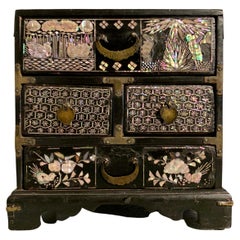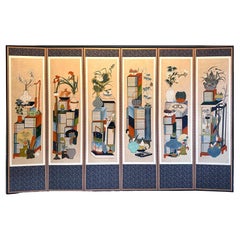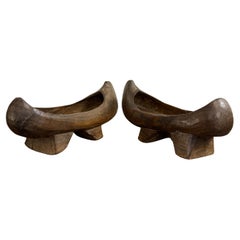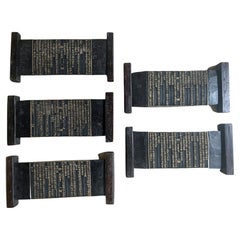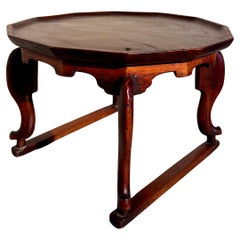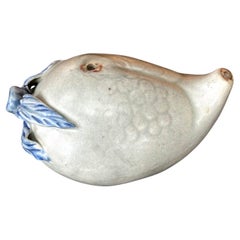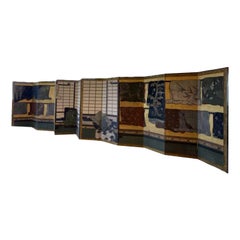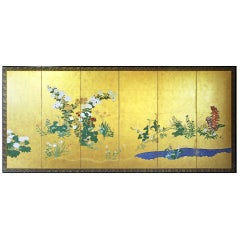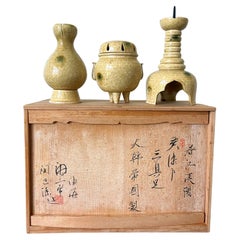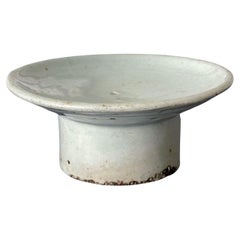Korean Scholar's Objects
to
1
18
20
1
5
11
4
2
14
5
2
1
1
954
418
392
288
76
20
20
20
Place of Origin: Korean
Korean Lacquered Wood and Mother of Pearl Inlay Chest, Joseon Dynasty, 19th c
Located in Austin, TX
A charming Korean keyaki (Japanese elm), lacquer, and mother-of-pearl inlaid personal accessory chest for a woman, Joseon Dynasty, early 19th century or earlier, Korea.
The small ac...
Category
Early 19th Century Antique Korean Scholar's Objects
Materials
Brass
Korean Folding Chaekgeori Painted Scholar Floor Screen
Located in Atlanta, GA
A six-panel painted folding floor screen from Korea circa early 20th century. This type of screen is called Chaekgeori (books and things) which is quite unique to Korea. It became popular at the end of 18th century favored and encouraged by King Jeongjo (1752-1800) as a political tool to promote social conservatism such as the traditional Confucianism value, especially considered important in a time when waves of new ideology influx came to Korea. Initially commissioned for the royal court, they became increasingly popular with the scholars of noble and affluent households and were used widely in their halls and studies. Early screens were painted with trompe-l’oeil bookcases displaying books and arrays of collectibles. Later, the bookcases were eliminated to focus on the assemblage of neatly stacked books and objects of scholarly pursue. On this screen, the six panels were neatly presented and framed in woven brocade borders. Among the stacked volumes, one can find many fine porcelain vases with flowers, potted orchids, pen holders with brush pens and scroll paintings, incense burner, ink stone, teapot, fan with ink painting, vessels of fruits, exotic plants such as lotus, plumeria and even a pair of glasses. It feels like a pleasant visual measure hunting for the viewers. Several words in Chinese found their way into the picture as well, including filial (xiao), longevity (shou) and luck (fu).
The painting was done in a meticulous way with no details overlooked and also with a rather western still-life dimensional perspective. In a rather unusual maximal but also minimalistic way, the screen exudes a historical charm with a folky flair but appears modern at the same time.
Each panel is 17.5"w by 70.2"h.
For general information on the subject see reference: Chaekgeori the Power and Pleasure of Possessions in Korean Painted Screens...
Category
20th Century Folk Art Korean Scholar's Objects
Materials
Brocade, Silk, Wood, Paper
A Pair of Wooden Clogs (Namaskin), Korea, Joseon Dynasty, 19th Century
Located in ARMADALE, VIC
A Pair of Wooden Clogs (Namaskin), Korea, Joseon Dynasty, 19th Century
with curved tips.
Provenance: Private Australian Collection.
Dimensions:
Height: 12.5cm.
Width: 28cm.
Depth: ...
Category
19th Century Antique Korean Scholar's Objects
Materials
Wood
Set of Five Korean Wood Print Blocks Joseon Dynasty
Located in Atlanta, GA
A set of five carved wood print blocks from Korea circa 1900s (late Joseon to early Korean Empire period). Constructed and hand-chiseled from hardwood, the printing blocks were finel...
Category
Early 20th Century Other Korean Scholar's Objects
Materials
Wood
Korean Zelkova Wood Tray Table, Soban, Joseon Dynasty, Mid 19th century, Korea
Located in Austin, TX
An elegant Korean serving tray / personal dining table, carved and joined zelkova (keyaki) wood, Joseon Dynasty, mid 19th century, Korea.
The elegant and sturdy tray table, known as...
Category
Mid-19th Century Antique Korean Scholar's Objects
Materials
Wood
Fine Antique Korean Ceramic Water Dropper Joseon Dynasty
Located in Atlanta, GA
A fine porcelain water dropper from Korea circa 19th century of the late Joseon Dynasty. Water dropper is one of the essential scholar objects in the Confucius Joseon society where ink calligraphy was considered an important cultivation of an educated man. The water dropper is a small contained made to drop the water onto the ink stone to grind the ink stick for writing. These miniature objects were made in various forms as little wonders as a desktop accessory for the Scholar's study.
The water dropper on offer was made of porcelain and covered in a grey celadon glaze. It was molded in the form of a beach with finely sculpted stalk and leaves. A slight red was dotted on the two openings. The surface also has a carved grape or pomegranate motifs under the glaze. There is some slightly running of the celadon glaze on top. The base has residues of kiln grits.
Although the peach form was perhaps one of the most common ones among the Korean water droppers...
Category
Early 19th Century Other Antique Korean Scholar's Objects
Materials
Ceramic
Korean Ceramic White Porcelain Water Dropper Joseon Dynasty
Located in Atlanta, GA
A small Korean water dropper in rectangular form with beveled edges, circa early 19th century of the Joseon Dynasty. The milky white porcelain pie...
Category
19th Century Other Antique Korean Scholar's Objects
Materials
Ceramic
Rare Korean Water Dropper in Doughnut Form Joseon Dynasty
Located in Atlanta, GA
A Korean blue and white porcelain water dropper in a rare hallowed out doughnut shape from Joseon Dynasty circa 1800s. The octagonal water droppe...
Category
Late 18th Century Other Antique Korean Scholar's Objects
Materials
Ceramic
Korean white Porcelain Ritual Incense Burner with Bagua Pattern Joseon Dynasty
Located in Atlanta, GA
An antique Korean ritual incense burner circa 19th century, late Joseon dynasty. It was made in Bunwon Kiln in Gwangju, Gyeonggi Do, near Seoul. The ceramic container has a thickly b...
Category
19th Century Archaistic Antique Korean Scholar's Objects
Materials
Ceramic
Korean Ceramic Water Dropper Joseon Dynasty
Located in Atlanta, GA
A small Korean ceramic water dropper in square form on four corner feet, circa 19th century late Joseon Dynasty. The piece features an underglaze blue pa...
Category
19th Century Antique Korean Scholar's Objects
Materials
Ceramic
Early 20th century Korean Garment Brush
Located in Chiba, JP
Old Korean garment brush used for hemp textile as scarce exposed type without covered grip, early 20th century, approx. L 24cm (9.44in), in used conditio...
Category
Early 20th Century Korean Scholar's Objects
Materials
Other
Small Korean White Ceramic Stem Bowl Joseon Dynasty
Located in Atlanta, GA
A ceramic stem bowl with high cylindrical pedestal foot in white glaze from Korea, circa 18 centuries of late Joseon Dynasty. By shape, this piece appears to be a ceremonial vessel t...
Category
18th Century Archaistic Antique Korean Scholar's Objects
Materials
Ceramic
Korean White Ceramic Stem Dish Joseon Dynasty
Located in Atlanta, GA
A ceramic dish with high cylindrical foot in white glaze from Korea, circa 19th century Joseon Dynasty. By shape, this piece is most likely a ceremonial vessel that was used to make offerings on the altar. Although without inscription, we can't rule out that it could be a household item for occasions that were less formal. Such as a private shrine in the household. During Joseon dynasty, the social morals were largely centered on the principles of Confucianism that originated from China. Many ritual ceramic wares were produced for rituals and worships on all level of the society. The ware were often modeled after the archaic bronze ware that elevated them from the aesthetic of daily use pieces. High foot dish like this were made in both round and square shape to suite different use but they were all distinguished with the inscription for their exclusive ceremonial purpose.
Of elegant form and harmonious proportion, this stem dish...
Category
19th Century Archaistic Antique Korean Scholar's Objects
Materials
Ceramic
Korean Seal Paste Box, Signed
Located in Savannah, GA
A Korean seal paste box, signed.
4 ½ inches wide by 1 ½ inches tall
Category
20th Century Other Korean Scholar's Objects
Materials
Ceramic
Korean Ceramic Celadon Deep Bowl Goryeo Dynasty
Located in Atlanta, GA
A ceramic bowl with celadon glaze from Korea, circa 14th century (late Goryeo Dynasty). The particular shape of the bowl suggests that it is likely a "Bo" (Chinese) or "Hattara" (Japanese "Oryoki"). This is a Buddhism term derived from Sanskrit word "patra", which means "vessel that contains just enough". The container was used traditionally by Buddhist monks to ask for alms (donated foods by laymen). The deep volume and the wide opening are conducive to its utility function. The bowl is covered in a jade-color celadon which has very fine and uniform crackles throughout. Upon close inspection of the exterior wall, one can detect a very light brush of white slip circumventing the body. The white slip brushing technique only became popular from 15th century on as a landmark of the Buncheong ceramics...
Category
15th Century and Earlier Archaistic Antique Korean Scholar's Objects
Materials
Ceramic
Korean Ceramic Water Dropper in Mountain Form Joseon Dynasty
Located in Atlanta, GA
A Korean ceramic water dropper in the shape of a mountain from late Joseon Dynasty circa 1850-1900s. The lovely piece takes a shape of a rugged mountain peak with crags and furrows, ...
Category
Late 19th Century Other Antique Korean Scholar's Objects
Materials
Ceramic
Korean Ceramic Ritual Offering Vessel with Inscription Joseon Dynasty
Located in Atlanta, GA
A ceramic dish with high cylindrical foot in white glaze with a cobalt blue underglaze inscription from Korea, circa 18-19th century Joseon Dynasty. This is a classic ceremonial vess...
Category
Late 18th Century Archaistic Antique Korean Scholar's Objects
Materials
Ceramic
$3,200 Sale Price
46% Off
Korean Porcelain Water Dropper Joseon Dynasty
Located in Atlanta, GA
A small Korean ceramic water dropper in square form circa 19th century late Joseon Dynasty. It features an underglaze blue painting of a full cluster of ...
Category
19th Century Other Antique Korean Scholar's Objects
Materials
Ceramic
Korean Ceramic Ritual Offering Stemmed Dish with Inscription Joseon Dynasty
Located in Atlanta, GA
A small ceramic stemmed dish with high cylindrical foot in white glaze with a cobalt blue underglaze inscription in the center from Korea, circa 18-19th cent...
Category
Late 18th Century Archaistic Antique Korean Scholar's Objects
Materials
Ceramic
Korean Ceramic Water Dropper in Dog Form Joseon Dynasty
Located in Atlanta, GA
A lovely Korean ceramic water dropper in the form of a sitting dog circa 19th century late Joseon Dynasty. The charming animal form features underglaze blue paint outlining the furs ...
Category
19th Century Antique Korean Scholar's Objects
Materials
Ceramic
Related Items
17th Century 'Late 1600s', Japanese Edo Period 12-Panel Folding Screen Painted
Located in North Miami, FL
A pair of 17th Century (Late 1600s) Japanese Edo screens made of 12-panels. This folding silk screen is painted on a gold leaf background. It has a...
Category
17th Century Edo Antique Korean Scholar's Objects
Materials
Silk, Wood, Paint, Paper
$595,000 / set
H 68.5 in W 292 in D 0.75 in
Edo Landscape Japanese Folding Screen
By Japanese Studio
Located in Brescia, IT
Refined work by a painter from the first half of the 19th century, from the landscape of the "Rinpa" school by a painter from the end of the 18th century, the Rinpa school.
Six panels painted in ink on gold leaf and "gofun" on vegetable paper.
The flowers are made with the "gofun" technique, natural or pigmented white oyster powder.
Rinpa is one of the major historical schools of Japanese painting. The style was consolidated by the brothers Ogata Korin (1658–1716) and Ogata Kenzan (1663–1743).
This folding screen has a very clean design that leaves plenty of room for the beautiful golden landscape.
It comes flat and you can easily hang it with our hooks.
Lucio Morini...
Category
18th Century Edo Antique Korean Scholar's Objects
Materials
Gold Leaf
Japanese Stone Object medium / wabi-sabi
Located in Sammu-shi, Chiba
This is an old Japanese stone object.
This stone object has a beautiful black and beige gradation.
An art object that gives you a sense of wabi-s...
Category
15th Century and Earlier Japonisme Antique Korean Scholar's Objects
Materials
Stone
Chinese Carved Longyan Wood Stand, Late Qing Dynasty
Located in Austin, TX
An exquisite late Qing dynasty display Stand of longyan wood, carved as a miniature "kang" table.
The center panel features an amazing grain that delights the eye, while a soft glo...
Category
Early 1900s Qing Antique Korean Scholar's Objects
Materials
Fruitwood
Antique Chinese Celadon Green Jade Carving, Triple Vase, Qing Dynasty
Located in New York, NY
An extremely finely carved antique Chinese Qing dynasty, Celadon green triple vase/brush washer with an Imperial Dragon from behind attacking a bird in fro...
Category
19th Century Qing Antique Korean Scholar's Objects
Materials
Jade
$18,200 Sale Price
20% Off
H 4 in W 2 in D 10 in
A Finely Cast Standing Bronze Figure of Guanyin, 17th / 18th Century
Located in Ottawa, Ontario
The finely cast bronze figure of Guanyin - Bodhisattva Goddess of Compassion, Kindness & Mercy.
Shown wearing an outer robe finely modelled with cascading folds tied at her waist, h...
Category
1690s Qing Antique Korean Scholar's Objects
Materials
Bronze
Chinese Cloisonne Incense Tool Vase, Qing Dynasty, 18th/19th Century, China
Located in Austin, TX
A small and elegant Chinese cloisonné vase for incense tools, Qing Dynasty, 18th/19th century, China.
Made for the scholar's studio, this small refined vase, was used to hold incense tools, including a small pair of tongs or chopsticks and spoon. The tools no longer present.
Of miniature baluster vase form, the vase beautify proportioned and decorated in the cloisonné enamel technique, with gilt wires forming the cloisons, or partitions. Within the cloisons, colorful enamels have been expertly laid.
The small incense tool vase...
Category
Early 1800s Qing Antique Korean Scholar's Objects
Materials
Copper, Enamel
$6,800
H 3.75 in Dm 1.75 in
19th Century Chinese Carved Giltwood Panel
Located in San Diego, CA
Antique 19th century Chinese carved gold gilt and painted wood wall panel or plaque with scholar and warrior figures scene. Signed on back as p...
Category
19th Century Antique Korean Scholar's Objects
Japanese Antique Zen Rosewood Mala Prayer Bead String 800 Beads With Alms Bowl
Located in South Burlington, VT
Rare find!: 24 feet long Zen monk Mala Prayer Bead String plus original wooden alms bowl with its original attached triangular shaped stone ojime.
A huge...
Category
Early 20th Century Meiji Korean Scholar's Objects
Materials
Wood
$360 Sale Price / set
58% Off
H 0.6 in W 283 in D 0.6 in
Japan Gold Gilt Good Luck Elephant Censer
Located in South Burlington, VT
Rare find: Ancient Japanese design gilt censer of a good luck elephant- signed Japan
This model elephant sculptural LED candle holder and censer was crafted in a handsome gilt finish iron of an effigy of an ancient elephant...
Category
Mid-20th Century Korean Scholar's Objects
Materials
Iron
Japanese "Suiseki" Mountain View Scholar's Stone / Elegant Mountain Scenery
Located in Sammu-shi, Chiba
This is a stone mined in Japan.
Not only in China but also in Japan from ancient times, rocks in the mountains have been shaved and stones for viewing have been quarried.
Such stones for appreciation are collectively called "suiseki".
Suiseki means "water" and "stone".
The name comes from the fact that I enjoyed pouring water on the stones and changing the color of the stones.
And this item is also Suiseki, but it is for viewing without splashing water.
It is made with the image of a mountain view.
The flow of the river...
Category
Mid-20th Century Showa Korean Scholar's Objects
Materials
Stone
$1,000
H 4.89 in W 12.92 in D 3.94 in
Antique Korean Bandaji Chest Pyongyang Joseon Dynasty
Located in Atlanta, GA
A striking Korean Bandaji with beautiful condition and patina circa 19th century of late Joseon Dynasty. Bandaji is known as drop front half-opening chest that was used to store fami...
Category
19th Century Other Antique Korean Scholar's Objects
Materials
Metal
Previously Available Items
Set of Ki-Seto Ceramic Altar Pieces from Korean Empire Period
Located in Atlanta, GA
A set of three ki-seto (yellow-seto) ceramic altar pieces made in the period of Korean Empire (1897-1910), a short independent period after Joseon dynasty before the invasion and occupation by Japan. The set consists of a candle holder with a metal pricket, an incense burner with lid and a vase. Traditionally, there were used during ritual ceremony as the accoutrement for a small altar table...
Category
Early 20th Century Other Korean Scholar's Objects
Materials
Ceramic
Small Korean White Ceramic Stem Dish Joseon Dynasty
Located in Atlanta, GA
A ceramic dish with high cylindrical foot in white glaze from Korea, circa 19th century late Joseon Dynasty. By shape, this piece appears to be a ceremonial vessel that was used to make offerings on the altar. Although without inscription, we can't rule out that it could be a household item for occasions that were less formal. Such as a private shrine in the household or even daily use for presenting foods. During Joseon dynasty, the social morals were largely centered on the principles of Confucianism that originated from China. Many ritual ceramic wares were produced for rituals and worships on all level of the society. The ware was often modeled after the archaic bronze ware...
Category
19th Century Archaistic Antique Korean Scholar's Objects
Materials
Ceramic
Large Korean Folding Chaekgeori Books and Scholars' Possessions Floor Screen
Located in Atlanta, GA
A rare and very well-preserved folding floor screen from Korea circa early 20th century. This type of screen is called Chaekgeori (books and things) which is quite unique to Korea. It became popular at the end of 18th century favored and encouraged by King Jeongjo (1752-1800) as a political tool to promote social conservatism such as the traditional Confucianism value, especially considered important in a time when waves of new ideology influx came to Korea. Initially commissioned for the royal court, they became increasingly popular with the scholars of noble and affluent household and used it widely in their halls and studies. Early screens were painted with trompe-l’oeil bookcases displaying books and arrays of collectibles. Later, the bookcases were eliminated to focus on the assemblage of neatly stacked books and objects of scholarly pursue. On this screen, the six panels were neatly presented and framed in woven brocade borders. Among the stacked volumes, one can find many fine porcelain vases with flowers, potted orchids, pen holders with brush pens and scroll paintings, incense burner, ink stone, teapot, fan with ink painting, vessels of fruits, exotic plants such as lotus, plumeria and even a pair of glasses. It feels like a pleasant visual measure hunting for the viewers. Several words in Chinese found their way into the picture as well, including filial (xiao), longevity (shou) and luck (fu).
The painting was done in a meticulous way with no details overlooked and also with a rather western still-life dimensional perspective. In a rather unusual maximal but also minimalistic way, the screen exudes a folky charm but appears modern at the same time.
Each panel is 17.5"w by 70.2"h.
For general information on the subject see reference: Chaekgeori the Power and Pleasure of Possessions in Korean Painted Screens...
Category
20th Century Folk Art Korean Scholar's Objects
Materials
Brocade, Silk, Wood, Paper
Korean Blue and White Ceramic Jar Joseon Dynasty
Located in Atlanta, GA
This Korean ceramic storage jar is dated to late Joseon or Yi dynasty, circa 19th century. It has a Classic rounded form with a short mouth lip and base ring, slightly irregular from...
Category
19th Century Antique Korean Scholar's Objects
Materials
Ceramic
Vintage Korean Reverse Painted Ox Horn Brass Jewelry Cabinet, 1940s
Located in Austin, TX
A wonderful vintage Korean brass jewelry cabinet with inset reverse painted ox horn panels, 1940s.
The jewelry chest, or possibly collectors cabinet, is in th...
Category
1940s Vintage Korean Scholar's Objects
Materials
Brass
19th Century, Korean Pearwood Scholar's Box
Located in Austin, TX
A rare and beautiful Korean brass-mounted pearwood scholar's box.
Of simple form and construction, conforming to Confucian literati ideals, the rectangular box has minimal decoratio...
Category
Late 19th Century Antique Korean Scholar's Objects
Materials
Brass
Korean Bandaji Scholar's Chest
Located in Banner Elk, NC
Bandaji book storage chest, Chonju-style, three drawers above double doors and drop door in center, with handle on either side, with Chinese locks, early 20th century, Korean.
Category
Early 19th Century Antique Korean Scholar's Objects
Recently Viewed
View AllMore Ways To Browse
Chinese Wood Carved Brush Pot
Japanese Suiseki
Lingbi Stone
Archer Ring
Glass Overlay Chinese Snuff Bottle
Lingbi Scholar Stones
Chinese Bone Horse
Jade Scholar Stone
Antique Bamboo Brush Pots
Antique Chinese Brush Holder
Taihu Stone
Qing Ink Stone
Vintage Paint Brush Horse Hair
Carved Bone Horses
Antique Chinese Carved Bamboo Brush Pot
Antique Chinese Snuff Bottles Inside Painted
Jade Archer
Calligraphy Brush Stand
